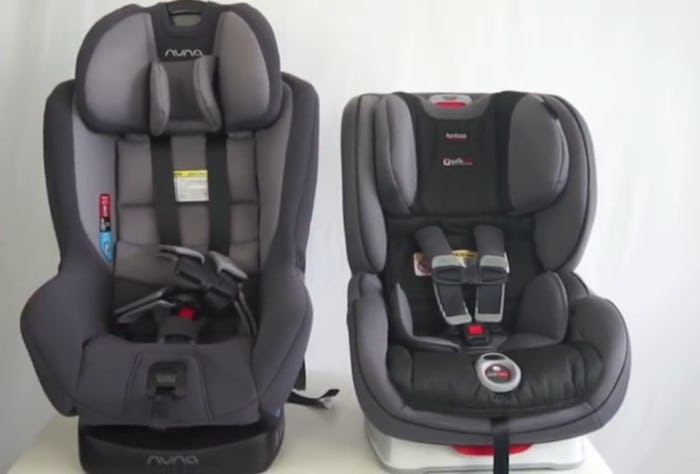Life
Convertible Car Seat Guidelines Every Parent Needs To Be Aware Of
If you're expecting a baby, you've probably been cramming all the information you can into your brain, learning about sleep training, when and how to introduce solid food, and what different cries mean. Perhaps you've already read up on the different types of car seats, and you've decided that the convenience of an infant bucket doesn't quite override the cost-effectiveness of one that grows with your child, from birth to booster. Unfortunately, you've still got more to learn, but I'll try to make it as painless as possible. Here are all the convertible car seat guidelines parents should know. And don't forget to forward the info along to your partner, siblings, nanny, in-laws, or whomever else might be ferrying your precious cargo around town. Even if they've already been to this rodeo, the rules are always changing, and it's important to be prepared.
If this is your first foray into the world of car seat study, here's a quick explainer on the different types: infant or rear-facing seats are, as you'd assume, seats designed for use from birth to age 2 (ish — I'll explain later), and they face backwards. They usually contain padded inserts to position your tiny, fresh-out-of-the-oven baby, which can later be removed as they grow. Forward-facing car seats are for kids who have exceeded the height and weight limits for their infant seat, and booster seats are for big kids (around ages 5 to 10, depending on their height and weight). Convertible seats are two, three, or even four seats in one, depending on the model, which can save you hundreds of dollars over the years.
First of all, it's important to check the minimum and maximum height and weight requirements when choosing a car seat. Just because a convertible car seat can be rear-facing doesn't necessarily mean that it's designed to hold a newborn; some are approved to carry babies as small as three pounds, while others have a minimum weight of 20 pounds or more. Likewise, some have to be traded in once a child hits 65 pounds, while others convert to a booster that can support up to 120 pounds.
If you're hoping to keep your child in the same seat until middle school, be sure to check the expiration date, too. Yes, that's actually a thing, and it's legit. Car seat technology continues to advance, and using an older one might mean that it's not up to date on the latest safety features. Additionally, the plastic and Styrofoam materials of the seat degrade over time, according to NBC Chicago, particularly in extremely hot or cold weather (and I'm willing to bet your region sees at least one of those occasionally). So make sure that yours is designed to last for another decade before committing.
Finally, just because a convertible car seat can face forward doesn't mean that it should; as much as you hate not being able to see your baby's face in the rear-view mirror, rear-facing is the safest option, according to the American Academy of Pediatrics, and it's always best to err on the side of caution. While you'll often hear that age 2 is the magic number for turning that seat around, it's actually the height and weight of the baby that matters, and that depends on the individual seat. True, most babies will hit that size around age 2, but we've all seen gigantic toddlers and tiny kindergarteners before. People aren't uniformly sized! You don't have to commit your seat's limits to memory, though, because it should be clearly labeled — on the side, if you're lucky. Just take a peek every now and then when you're strapping your child in, and if you're eager to make the switch, trying feeding them even more food. I'm kidding! Please don't.
Check out Romper's new video series, Romper's Doula Diaries:
Watch full episodes of Romper's Doula Diaries on Facebook Watch.
